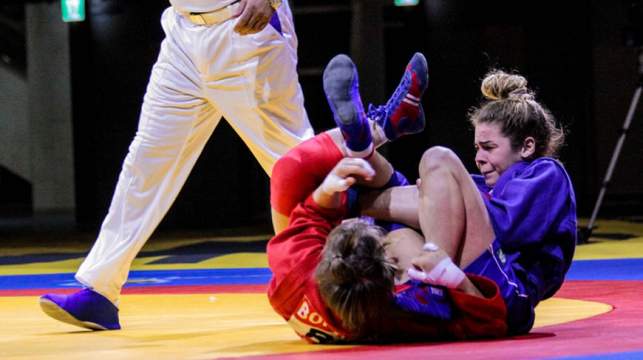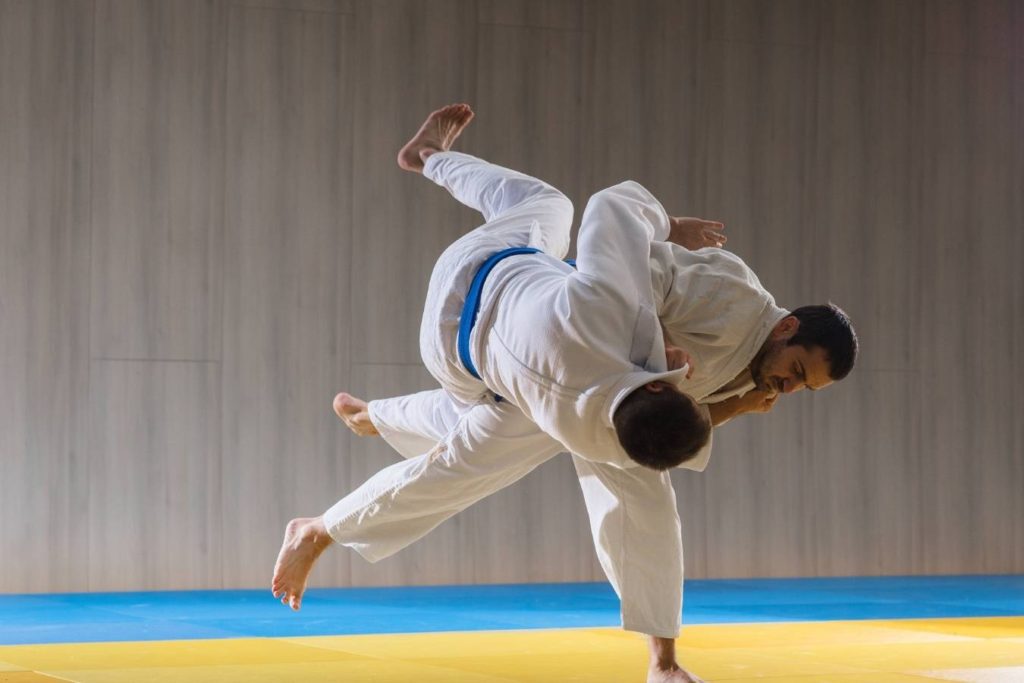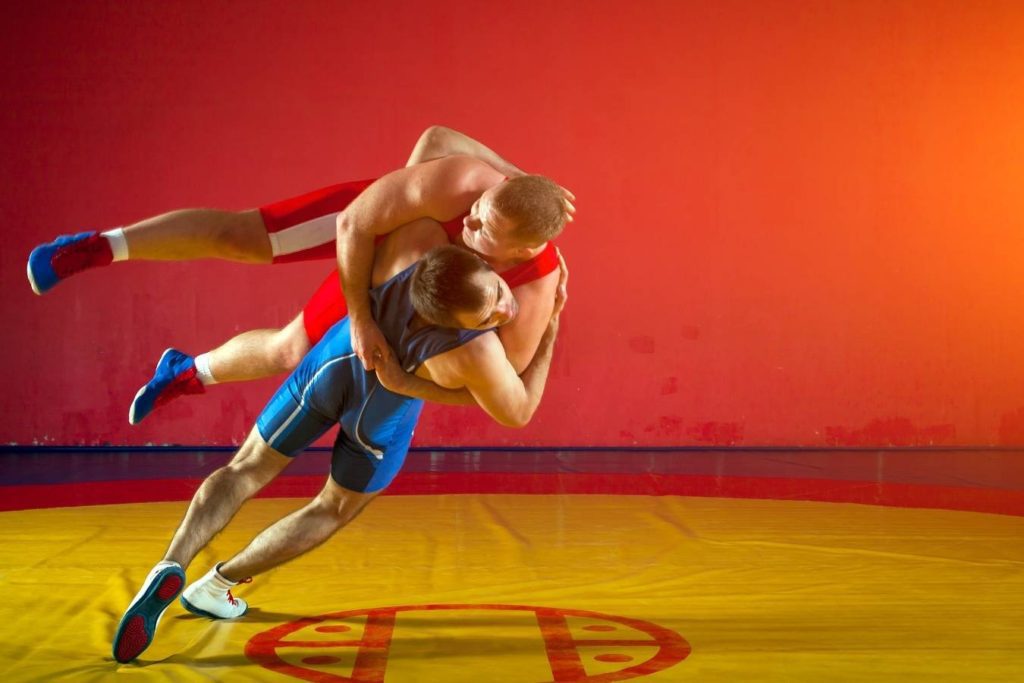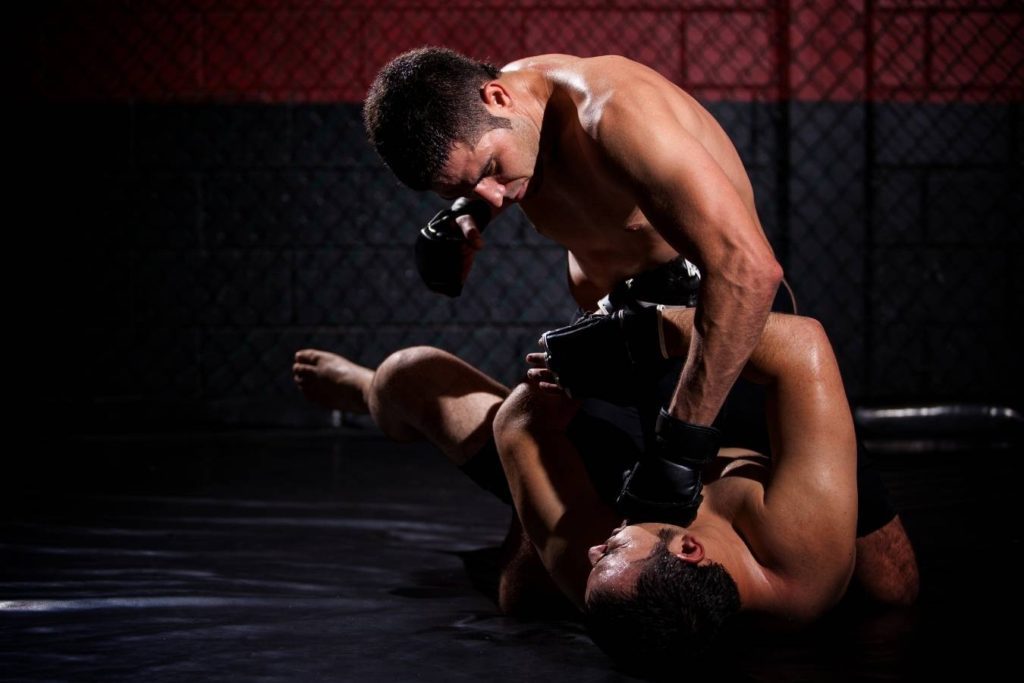Sambo is a famous combat sport that was influenced by a combination of martial arts which originated in Russia. There are various styles of Sambo but the ones that are most popular are Combat and Sport Sambo. However, he rules differ depending on the style you are practicing
Some of the most famous MMA fighters that have a Sambo background are Khabib Nurmagomedov and Islam Makhachev.
Sambo resembles Judo and wrestling quite closely. However, it is not recognized as an Olympic sport yet. Outside of Russia and the USSR, Sambo is rather unknown or very niche. This definitive guide will give you everything you need to know about Sambo.
If you’d like to see Sambo in action, check out the video below.
What Does Sambo Mean in English?
When you type “Sambo” in the search bar, you’ll get two results with a racial term and martial arts written in brackets with each. According to one definition, Sambo was used in old American and British English for African people of various degrees of European admixture. It is mostly considered as a racial slur and shouldn’t be used at all.
However, this term is also used for an internationally practiced Soviet combat sport. Sambo is actually an acronym of a Russian phrase “SAMozashchita Bez Oruzhiya”, which literally means “self-defense without weapons”.
It is referred to as Sambo for the sake of brevity. The goals of Sambo change with the style, however, it mainly teaches you how to end fights quickly. This is more than often done by taking an opponent down and submitting them or finishing with strikes.
A Brief History of Sambo

Sambo came into existence in the early 20th century. It was integrated into the hand-to-hand training regimen of the Soviet Union’s Red Army.

How to Dominate Every Fight with Raw, Explosive Power No One Can Match
Discover the underground blueprint that has quietly turned MMA hopefuls into legends, using nothing but sheer, brute force and bulletproof conditioning techniques.
There were three men who played a big role in the creation of Sambo; one of them, named Viktor Spiridonov, was a World War I veteran who had a background in wrestling and Ju-jitsu (Japanese martial arts).
Spiridonov, who had sustained an injury in WWI, worked in the physical training center of the Red Army and mostly focused on creating techniques that emphasized movements over strength.
His ultimate goal was to make a combat style that combined the most effective parts of different martial arts and wrestling styles. The style of hand-to-hand combat that he developed was called “Samoz”, which could be used by weak or injured soldiers.
A soldier named Vasili Oshchepkov, who also worked in the Red Army, developed another hand-to-hand fighting system. He used his extensive background in Judo and incorporated it into the fighting system that he had formed.
Both Spiridonov and Oshchepkov rarely crossed paths but, due to the efforts of the students of both of the men, a mixture of the techniques of the fighting systems occurred that was called Sambo.
However, in 1937, when tensions increased between Japan and the Soviet Union, Oshchepkov was suspected to be a Japanese spy, and Sambo was disregarded as a Japanese sport. It would have died, had it not been for the efforts of another man: Anatoly Kharlampiyev.
He was Oshchepkov’s student and he took to clever political maneuvering and rewriting of Sambo’s history. He emphasized the Russian roots of the fighting style in the Samoz by Spiridonov.
By 1938, it was declared as a martial art by the All USSR Sports Committee and became the official combat sport of the nation. This is also why Kharlampiyev is officially known as the “father of Sambo”.
What Are The Different Kinds of Sambo?
Different styles of Sambo were introduced since its formulation. However, only the following six are recognized by the general public:
Combat Sambo
This style of Sambo was made for the military. It includes usage of weapons and disarming techniques. It also allows for various striking and grappling moves. The various strikes include groin kicks, head butting, and the use of elbows and knees. It is similar to MMA (mixed martial arts).
Sport Sambo
A competitive form of Sambo that is very similar to Judo and wrestling. The rules allow all types of leg locks. The techniques that are commonly used include grappling, leg locks, and takedowns.
Freestyle Sambo
This type of Sambo was introduced by the American Association of Sambo in 2004. Their purpose was to encourage non-Sambo practitioners such as those of Judo and Ju-jitsu to participate in Sambo. Freestyle Sambo allows the use of chokeholds and other submission techniques that are not used in Sport Sambo.
Self-Defense Sambo
This type of Sambo is about defending oneself. In it, the practitioners are taught how to protect themselves against weapons. Most of the moves that are taught include using the aggression of the attacker against them, which is similar to what is done in both Jujitsu and Aikido. Spiridonov’s influence is strong in this style of Sambo.
Special Sambo
This type of Sambo was made for the Special Forces of the Army and other rapid response forces. It is only designed for the particular group that uses it. In that sense, it is similar to combat Sambo, which is also developed for a specific aim.
Beach Sambo
Beach Sambo, as the name suggests, is performed on beaches or soft strips of sand.
How is Sambo Different from Judo?

Given the history of Sambo, you won’t be surprised to know that Sambo is very similar to Judo; however, there are areas where they are clearly different. For example, chokeholds are allowed in Judo but not in Sambo – specifically Sport Sambo.
While non-rotation leg locks are allowed in Sport Sambo, but not in Judo. Also in Judo, when you want to submit your opponent, you can do so by attacking their elbow joint, which is not permitted in Sambo.
You can also win in Judo by pinning your opponent down to the ground, while in Sambo it will only give you points.
Judo is a grappling martial art. It is a mixture of takedowns and control with submission. However, now there are many new rules that are developed for Judo and it focuses more on takedowns and control compared to submissions.
Sambo brings that focus back to the submission game and reduces the rules. It gives the competitors more time to work on the ground.
Ways to Win
In Sambo, whoever has more points at the end of the match wins. You also win when you have a lead of 12 points. Another way to win is by performing a perfect throw. A perfect throw is when you take a person down and they fall on their back with a significant force. You can also win when you submit your opponent.
In Judo, you can win by performing a perfect throw known as an ippon. Other ways to win include pinning your opponent to the ground for 20 seconds, submitting them, performing an almost perfect throw two times and pinning your opponent to the ground for 10 to 19 seconds two times.
Equipment
Sambo practitioners wear a gi like top called the kurtaka with a belt. However, unlike Judo, Sambo players wear wrestling style shorts and boots. Judo practitioners wear a full gi and a belt.
Time of Origin
As we have already discussed, Sambo was formulated in the 1920s by Russian military personnel and officiated later as a national sport. Judo is comparatively older; its origin dates back to the 1880s in Japan.
Duration
The match duration for Sambo is 5 minutes. In Judo, the match duration varies according to age. It is 5 minutes for adults, 3 minutes for children and people over 30 years old.
How is Sambo Different from Wrestling?

Sambo is heavily influenced by various martial arts, which also includes wrestling. The key difference between the two is that wrestling is mainly a physical competition, where one opponent tries to overpower the other by using various grappling techniques. It is mostly about takedowns and control. No submissions are allowed.
In Sambo, you can win by submitting your opponent. You can grab the opponent from their jacket and make a perfect throw, while in wrestling there are no jackets to begin with.
In wrestling, when you pin down your opponent, you need to hold his/her shoulders down for 1 to 2 seconds to score. The conditions are the same in Judo and Sambo but you need to hold down your opponent for 20 seconds.
Ways to Win
In Sambo, the practitioner wins by having more score at the end of the match, by achieving a 12-point lead, performing a perfect throw, or by making the opponent submit.
In wrestling, a person needs to pin the other for 1-2 seconds, achieve a 10-point lead, or by having more points at the end of the match in order to win.
Equipment
A wrestler wears a singlet, headgear, and shoes which is much different from the gi style kurtaka Sambo practitioners wear.
Time of Origin
We already know the time of origin of Sambo, but wrestling is much older. According to some, it came into existence about 15000 years ago.
Duration
A match of Sambo is concluded in 5 minutes but wrestling takes a bit longer than that. Opponents have to compete against each other in three 2-minute periods, each with a 30-seconds break.
Does Sambo Have Striking Techniques?

Striking is not allowed in every type of Sambo; for example, it is permitted in Combat Sambo but not in Sport Sambo. Combat Sambo is almost like MMA because all the striking techniques that are allowed in MMA are performed in it and even some that are not.
Even though striking is allowed, it is not scored. Points are given for pinning and throwing. You can strike your opponent several times but if your opponent throws you or dominates you, they will get the win.
The only thing related to striking that is scored is a knockdown. You can win by performing two knockdowns. One knockdown gives you 4 points. You can win the match if your opponent quits due to strikes or if you knock your opponent out using strikes.
In Combat Sambo, you can kick, throw punches, knees, or elbows both in a standing position and on the ground. The only time you are not permitted to throw elbows is when you are dragging your opponent by the sleeves.
You also can’t stop your opponent from taking you down by throwing a knee to the head. You can’t throw strikes with fingers either, but you can hit with the palm of your hand. You are also not allowed to hit your opponent in the back of the head, back, neck, and arm joints. Other than that, you can throw head-butts and even shin strikes in Combat Sambo.
Does Sambo Include Chokes?
This depends on which style of Sambo you are practicing. For example, in Combat Sambo, all kinds of strikes and submission forms are allowed but choking is not permitted.
You can, however, use leg locks to take your opponent down and submit them. That is why another form of Sambo was created, which is called Freestyle Sambo. It permits the use of a chokehold in order to submit your opponent.
Is Sambo an Olympic Sport?
No, Sambo is not an Olympic sport yet. There was a time when it was almost accepted as an Olympic sport but that didn’t happen. It is very popular and is practiced widely in Russia and some other former socialistic states in Europe and Asia.
However, since it is not recognized as an Olympic sport, many practitioners learn and practice other Olympic martial arts sports such as Judo and wrestling, since that is their only chance to compete in the Olympics.
Politics and lack of popularity are the reasons for Sambo not being an Olympic game. Another reason could be that, since there are already three types of wrestling sports (Freestyle wrestling, Judo, and Greco-Roman Wrestling) in the Olympics, the committee wouldn’t want to include another similar sport.

